Passenger carriers
North Dakota train stations | ||||||||||||||||||||||||||||||||||||||||||||||||||||||||||||||||||||||||
|---|---|---|---|---|---|---|---|---|---|---|---|---|---|---|---|---|---|---|---|---|---|---|---|---|---|---|---|---|---|---|---|---|---|---|---|---|---|---|---|---|---|---|---|---|---|---|---|---|---|---|---|---|---|---|---|---|---|---|---|---|---|---|---|---|---|---|---|---|---|---|---|---|
| ||||||||||||||||||||||||||||||||||||||||||||||||||||||||||||||||||||||||
- Amtrak (AMTK)
The following railroads operate in the U.S. state of North Dakota.
North Dakota train stations | ||||||||||||||||||||||||||||||||||||||||||||||||||||||||||||||||||||||||
|---|---|---|---|---|---|---|---|---|---|---|---|---|---|---|---|---|---|---|---|---|---|---|---|---|---|---|---|---|---|---|---|---|---|---|---|---|---|---|---|---|---|---|---|---|---|---|---|---|---|---|---|---|---|---|---|---|---|---|---|---|---|---|---|---|---|---|---|---|---|---|---|---|
| ||||||||||||||||||||||||||||||||||||||||||||||||||||||||||||||||||||||||

BNSF Railway is one of the largest freight railroads in North America. One of eight North American Class I railroads, BNSF has 35,000 employees, 32,500 miles (52,300 km) of track in 28 states, and nearly 8,000 locomotives. It has three transcontinental routes that provide rail connections between the western and eastern United States. BNSF trains traveled over 169 million miles in 2010, more than any other North American railroad.

The Burlington Northern Railroad was a United States-based railroad company formed from a merger of four major U.S. railroads. Burlington Northern operated between 1970 and 1996.

The Red River Valley and Western Railroad is a regional railroad operating in the US states of North Dakota and Minnesota. It began operations in 1987 in an era of railroad restructuring.

The Crescent Bridge carries a rail line across the Mississippi River between Davenport, Iowa and Rock Island, Illinois. It was formerly owned by the Davenport, Rock Island and North Western Railway, a joint subsidiary of the Chicago, Burlington and Quincy Railroad and Chicago, Milwaukee, St. Paul and Pacific Railroad, which was split in 1995 between then-joint owners Burlington Northern Railroad and Soo Line Railroad, with BN getting the bridge and the Illinois-side line, and Soo Line getting the Iowa-side line. Since then, after spinning off its lines in the area to I&M Rail Link, later Iowa, Chicago and Eastern Railroad, the lines were repurchased by the Canadian Pacific Railway, parent of the Soo Line. Meanwhile, BN has merged into the BNSF Railway, the current owner of the bridge.

The Twin Cities and Western Railroad is a railroad operating in the U.S. state of Minnesota which started operations on July 27, 1991. Trackage includes the former Soo Line Railroad "Ortonville Line", originally built as the first part of the Pacific extension of the Milwaukee Road. This main line extends from Hopkins, Minnesota to Appleton, Minnesota. The line was originally built between Hopkins and Cologne, Minnesota in 1876 by Hastings and Dakota Railroad. In 1913, the Milwaukee Road rerouted it, reducing the curves. The line was eventually extended to the Pacific.

The Minnesota Northern Railroad is a Class III shortline railroad that operates over 224 miles (360 km) of track in northwestern Minnesota. The railroad is co-owned by KBN Incorporated and Independent Locomotive Service and is headquartered in Crookston, Minnesota.

The St. Croix Valley Railroad is a Class III short line railroad that operates over 36 miles of track in eastern Minnesota. The railroad is owned by KBN Incorporated jointly between Independent Locomotive Service of Bethel MN and Midwest Locomotive Services of Atwater MN, with the railroad headquartered in Rush City, Minnesota.

The Dakota Northern Railroad is a Class III short line railroad that operates over 72 miles of track in the northeastern portion of the U.S. state of North Dakota. The Dakota Northern Railroad, headquartered in Crookston, Minnesota, is co-owned by KBN Incorporated and Independent Locomotive Service.

The Northern Plains Railroad is a short line railroad that operates over 344 miles (554 km) of track in the northern U.S. state of Minnesota and the northern U.S. state of North Dakota.

The Northern Transcon, a route operated by the BNSF Railway, traverses the most northerly route of any railroad in the western United States. This route was originally part of the Chicago, Burlington and Quincy Railroad, Northern Pacific Railway, Great Northern Railway and Spokane, Portland and Seattle Railway systems, merged into the Burlington Northern Railroad system in 1970.

Originally called the High Bridge, the Hi-Line Bridge is a historic railroad bridge located over the Sheyenne River in Valley City, North Dakota. The bridge is 3,860 feet (1,180 m) long and 162 feet (49 m) above the river. Construction work began on July 5, 1906 and it was ready for service on May 8, 1908. At the time it was the longest bridge for its height in the world. It currently remains one of the longest and highest single track railroad viaducts in the United States, and was designated as a National Historic Civil Engineering Landmark by the American Society of Civil Engineers in 2005.
The Yellowstone Valley Railroad is a 171-mile (275 km) shortline railroad in northeastern Montana, also crossing into North Dakota. It operates two branch lines leased from the BNSF Railway in 2005 - Snowden to Glendive and Bainville to Scobey - connected by trackage rights over BNSF's Northern Transcon between Snowden and Bainville.
The Morris Subdivision or Morris Sub is a railroad line that runs about 113 miles (182 km) from Breckenridge to Willmar, Minnesota. Currently operated by BNSF Railway, this was part of the Great Northern Railway's transcontinental line from Minneapolis to Seattle, Washington. Today, BNSF's Northern Transcon travels up the Staples Subdivision instead, which is a more direct route to Fargo, North Dakota.
The Moorhead Subdivision or Moorhead Sub is a railroad line which runs from Moorhead to Breckenridge, Minnesota. It briefly crosses the border into North Dakota around Wahpeton, across the Red River from Breckenridge. Currently operated by BNSF Railway, this was part of the Great Northern Railway's transcontinental line from Minneapolis to Seattle, Washington.